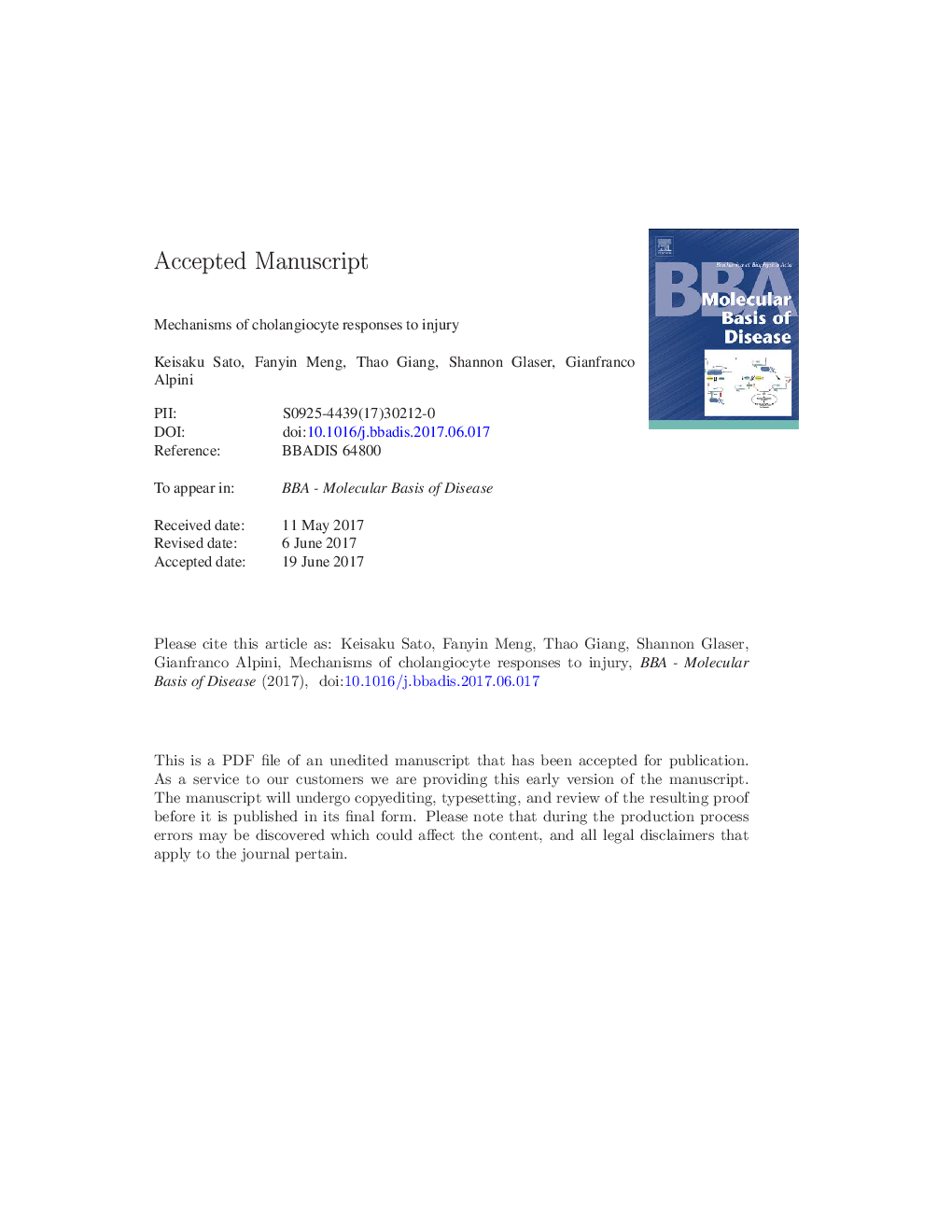| کد مقاله | کد نشریه | سال انتشار | مقاله انگلیسی | نسخه تمام متن |
|---|---|---|---|---|
| 8258502 | 1534609 | 2018 | 46 صفحه PDF | دانلود رایگان |
عنوان انگلیسی مقاله ISI
Mechanisms of cholangiocyte responses to injury
ترجمه فارسی عنوان
مکانیسم پاسخ های کولنگیوسیت به آسیب
دانلود مقاله + سفارش ترجمه
دانلود مقاله ISI انگلیسی
رایگان برای ایرانیان
کلمات کلیدی
VEGFRANITGPBAR1BDLAE2Pancreatic Duodenal Homeobox-1PDX-1CaMKIP3EVSCholangiocytesCFTRNK-1RIP3RS1PR2PBCSSTR2CCl4G protein-coupled bile acid receptor 1NAFLDGnRHNFATmiRNAsSphingosine 1-phosphate receptor 2GalR1α-naphthylisothiocyanatearylalkylamine N-acetyltransferaseMT1CCAPSCcAMP - cAMPprimary biliary cholangitis - Cholangitis اولیه صفراویinositol 1,4,5-trisphosphate - inositol 1،4،5-trisphosphateScT - ScT درadenosine 3′,5′-cyclic monophosphate - آدنوزین 3 '، 5'-سیکلیک منوفسفرهNon-alcoholic steatohepatitis - استئاتوهپاتیت غیرالکلیBiliary atresia - انسداد مجاری صفراوی، آترزی صفراویYAP - ایجادinterleukin - اینترلوکینnon-alcoholic fatty liver diseases - بیماری های کبدی چربی غیر الکلیExtracellular vesicles - حامل های خارج سلولیcystic fibrosis transmembrane conductance regulator - رگولاتور رسانایی فرابنفش فیبروز کیستیکmicroRNAs - ریز آرانایCAM - ساخت به کمک کامپیوترendoplasmic reticulum - شبکه آندوپلاسمی nuclear factor of activated T-cells - عامل هسته سلول های فعال شده فعال استAANAT - عنانVascular endothelial growth factor - فاکتور رشد اندوتلیال عروقیVascular Endothelial Growth Factor (VEGF) - فاکتور رشد اندوتلیال عروقی (VEGF)Substance P - ماده PBile Ducts - مجاری صفراویSecretin - مخترعNash - نوشGonadotropin-releasing hormone - هورمون آزاد کننده گنادوتروپینyes-associated protein - پروتئین مرتبط با بلهbile duct ligation - پیوند مجرای صفراویCalmodulin - کالمودولینCarbon tetrachloride - کربن تتراکلریدPrimary sclerosing cholangitis - کلانژیت اسکلروئیدی اولیهCholangiocarcinoma - کلانژیوکارسینومایCalcineurin - کلسینورینIP3 receptor - گیرنده IP3VEGF receptor - گیرنده VEGFSomatostatin receptor - گیرنده سوماتوستاتینSecretin receptor - گیرنده سکترونNeurokinin-1 receptor - گیرنده نوروکینین-1Galanin receptor 1 - گیرنده گالانین 1
موضوعات مرتبط
علوم زیستی و بیوفناوری
بیوشیمی، ژنتیک و زیست شناسی مولکولی
سالمندی
چکیده انگلیسی
Cholangiocytes, epithelial cells that line the biliary epithelium, are the primary target cells for cholangiopathies including primary sclerosing cholangitis and primary biliary cholangitis. Quiescent cholangiocytes respond to biliary damage and acquire an activated neuroendocrine phenotype to maintain the homeostasis of the liver. The typical response of cholangiocytes is proliferation leading to bile duct hyperplasia, which is a characteristic of cholestatic liver diseases. Current studies have identified various signaling pathways that are associated with cholangiocyte proliferation/loss and liver fibrosis in cholangiopathies using human samples and rodent models. Although recent studies have demonstrated that extracellular vesicles and microRNAs could be mediators that regulate these messenger/receptor axes, further studies are required to confirm their roles. This review summarizes current studies of biliary response and cholangiocyte proliferation during cholestatic liver injury with particular emphasis on the secretin/secretin receptor axis. This article is part of a Special Issue entitled: Cholangiocytes in Health and Diseaseedited by Jesus Banales, Marco Marzioni, Nicholas LaRusso and Peter Jansen.
ناشر
Database: Elsevier - ScienceDirect (ساینس دایرکت)
Journal: Biochimica et Biophysica Acta (BBA) - Molecular Basis of Disease - Volume 1864, Issue 4, Part B, April 2018, Pages 1262-1269
Journal: Biochimica et Biophysica Acta (BBA) - Molecular Basis of Disease - Volume 1864, Issue 4, Part B, April 2018, Pages 1262-1269
نویسندگان
Keisaku Sato, Fanyin Meng, Thao Giang, Shannon Glaser, Gianfranco Alpini,
